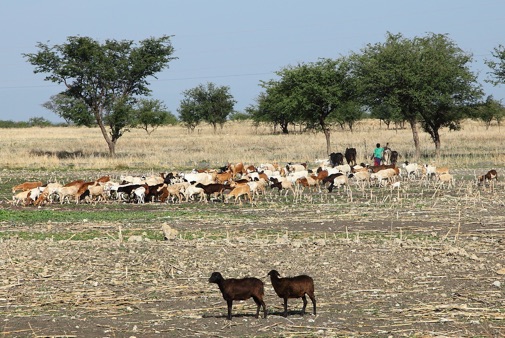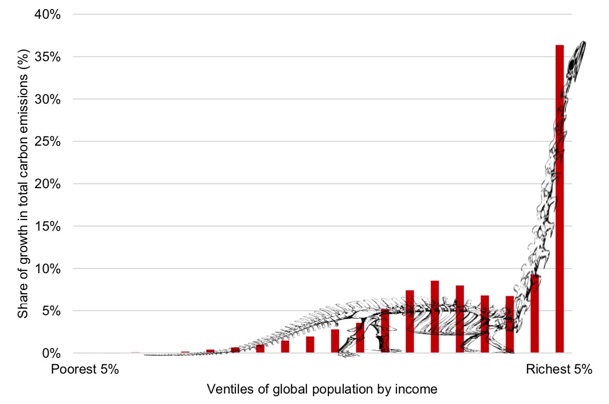News
26 September 2020
Income inequality impacts on the level of greenhouse gas emissions and on vulnerability to the consequences of climate change
While the COVID-19 pandemic holds the headlines and radically modified our everyday lives in a matter 6 months, climate change is taking place at an accelerated rate.
Greenhouse gas (GHG) emissions are increasing and the coming decade will be crucial for the climate
Between 1990 and 2015, global annual GHG emissions grew by 60%, roughly doubling the total cumulative emissions. According to the Intergovernmental Panel on Climate Change (IPCC), at this rate, the volume of emissions leading to an increase of global temperature by 1.5 degrees will have been released at some date between 2029 and 2034. At the same rate, the volume of GHGs that will result in a 2-degree rise of global temperature will have been released at some stage between 2050 and 2059. It is because of these forecasts that the coming decade will be crucial for our climate.

The rich emit more GHGs than the poor
In order to be better equipped to combat climate change and limit GHG emissions, it is essential to understand how they evolved in the recent past. A joint study by the Stockholm Environment Institute (SEI) and Oxfam demonstrates that the rich have emitted an overwhelming part of global GHG emissions:
-
•The richest one percent were responsible for 15 percent of emissions between 1990 and 2015 – more than all the citizens of the EU and more than twice that of the poorest half of humanity (7 percent);
-
•The richest 10 percent accounted for over half (52 percent) of the emissions during the same period.
It is clear from these data that in order not to surpass the remaining carbon budget (i.e. the volume of GHG emitted that would lead to an increase of 1.5 or 2 degrees of the global temperature), the effort required for cutting GHG emissions should not be borne equally by all. For the sake of justice, those who emit more, should also be those who have to reduce more drastically their GHGs.
This is justified because the amount of GHG emitted by the wealthy has been growing faster than that of the poor. The figures of the SEI/Oxfam report estimate that the 5 percent richest are responsible for over one third (37 percent) of the growth of GHG emissions between 1990 and 2015. This is illustrated by the carbon inequality “dinosaur” diagramme below and reinforces an idea we had proposed some time ago [read].
The carbon inequality “dinosaur” of emissions growth from 1990 to 2015

Source: SEI and Oxfam, 2020. (download diagramme: Dinosaure.jpg
In this diagramme, the world population is arranged in ventiles by income, from the poorest 5% on the left to the richest 5% on the right. The bars show each ventile’s increase in total emissions (as a percentage of total global emissions growth).
It should be easier for the highest GHG producers to reduce their emissions than for those who, being poor, consume less and therefore emit less.
The consequences of climate change become every year more visible and painfully tangible, particularly for the poorer population groups
The huge and tragic floods and fires observed throughout the world are no surprise. They confirm what had been forecasted by scientists both at international and national levels (see for example the Climate Science Special Report prepared by the U.S. government in 2017 and more specifically its chapter 15). However it seems that these extreme meteorological events are occurring several decades earlier than what had been expected and this may be a sign that climate change is accelerating [read].
According to the U.S. Drought Monitor, almost three quarters of the West of the U.S. is experiencing drought in 2020. This is part of a longer period of drought that has been spreading over the last twenty years. As a consequence, fires have been particularly spectacular and distressing this year. For example, record fires are hitting California and have already destroyed close to 14,000 square kilometres. Simultaneously, the Eastern part of the U.S. is getting wetter and the frequency and damage of hurricanes and their resulting floods increased [read].
Similar events can be observed elsewhere in the World where giant fires have been occurring in Amazonia, in South-East Asia and in Siberia.
In Sudan, record floods unseen since the late 1980s have led the government to declare a state of emergency, as more than 500,000 people are affected, the water destroying as much as 100,000 homes.
In China too, millions of people have been hit by floods that killed several hundreds and devastated housing and infrastructure.
Elsewhere in Asia, millions of people were displaced by floods in Bangladesh, India, Japan, Pakistan, Nepal, South Korea, Turkey and Vietnam.
Violent rains also brought damage to dwellings in the West African Sahel (in Niger, Nigeria and Senegal, in particular).
Moreover, a growing number of people are being exposed to extreme heat and humidity conditions that are above the thermoregulating capacity of the human body. Some data indicate that since 1979, extreme humid heat has more than doubled in frequency [read].
A study published in 2017 estimated that around 30% of the world population was then exposed for at least 20 days in the year to extreme heat conditions and that by the end of the century, this percentage would reach 48%, in the case greenhouse gases (GHGs) were drastically reduced, and 74%, in a scenario that would see the continued increase of these emissions [read]. Some areas may turn unfit for human life, while in other affected regions, productivity of labour will likely be strongly diminished during periods of extreme heat [read].
Heat waves have also become more frequent in Europe, even in places like Siberia - this may appear as a surprise to many -, while an absolute record of temperature was observed this year in Svalbard (Spitzberg) in the Arctic (located at 78 degree North).
Conclusion
The facts and figures that have been presented in this article show that:
-
•climate change is on the way and accelerating as GHG emissions have continued to grow between 1990 and 2015;
-
•the rich emitted much more GHGs than the poor;
-
•the consequences of climate change are being felt increasingly and the poor and vulnerable are likely to be much more affected - and more dramatically - than the rich, a they do not have the means to avoid them.
As a result, combatting climate change cannot be an across-the-board endeavour where all, irrespective of their specific conditions, will have to modify their behaviour, consumption patterns and GHG emission levels in the same way.
The rich, who emit more GHGs should make more efforts and reduce more drastically their emissions, while sufficient resources should be mobilised to assist the poor and vulnerable people who are particularly hit by extreme meteorological events.
Unless governments adopt a nuanced approach to climate change, it will be impossible to keep the increase of average world temperature below even 2 degrees.
At hungerexplained.org, we have recently made suggestions on how to try and tackle the climate issue from the food sector perspective, this sector being one of the main sources of GHG emissions [read].
We have also, yet more recently, proposed individual GHG emission accounts as tools that can help each of us to decide and monitor our emissions. These accounts could also serve us to define the rate of decrease of our individual (or family) GHG emissions, taking into consideration overall reduction commitments (at world and national levels) and our current levels of emission [read].
We believe that government authorities should seriously envisage implementing the policy changes recommended and promoting the individual/family GHG account to facilitate diminishing and monitoring GHG emissions.
—————————————
To know more:
-
•S. Kartha et al., The Carbon Inequality Era - An assessment of the global distribution of consumption emissions among individuals from 1990 to 2015 and beyond, Stockholm Environment Institute and Oxfam, 2020.
-
•D.J. Wuebbles, et al., Climate Science Special Report: Fourth National Climate Assessment (NCA4), Volume I, U.S. Global Change Research Program, 2017.
Selection of past articles on hungerexplained.org related to the topic:
-
•Opinions: Combatting climate change in our daily life, 2020.
-
•Opinions: Condemned to utopia ? Climate and democracy: changing our paradigm to preserve the climate and our future, 2020.
-
•The reduction of world forests erodes their ability to store carbon and conserve biodiversity, 2020.
-
•Policies for a transition towards more sustainable and climate friendly food systems, 2018.
For your comments and reactions: hungerexpl@gmail.com
Last update: September 2020


